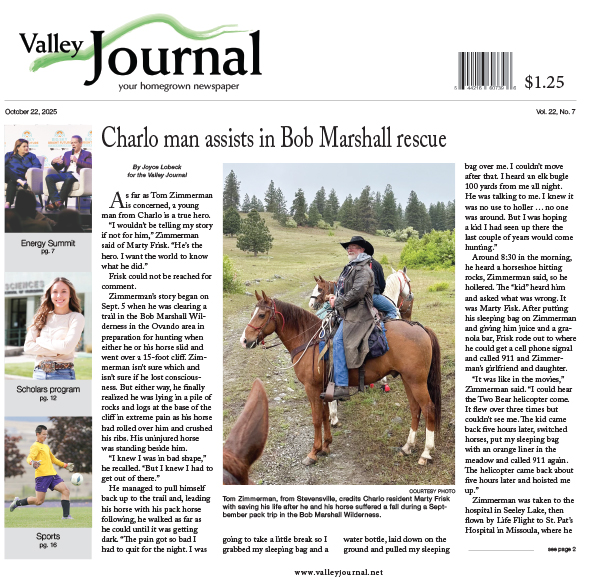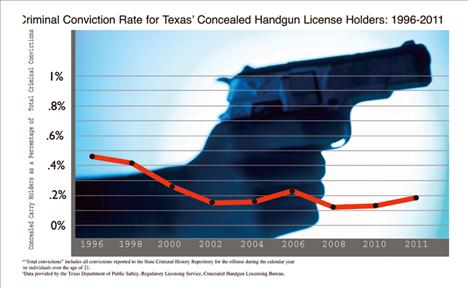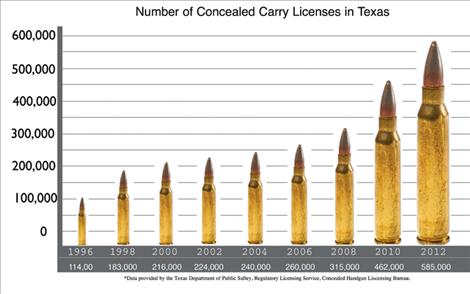Research, history point to benefits of concealed-carry laws
Hey savvy news reader! Thanks for choosing local.
You are now reading
2 of 3 free articles.
After Sandy Hook, schools across the nation started sending teachers to obtain their concealed-carry permits. As with most mass shootings in the United States, one of the inevitable debates chosen by political pundits, politicians and citizens alike is whether or not concealed-carry actually inhibits crime and, more bluntly, whether or not an armed teacher would have been able to stem the slaughter of 26 innocent people Dec. 14.
Concealed-carry: Does it prevent crime?
Opinions and statistics vary greatly as to whether or not concealed-carry actually prevents crime. As most legal uses of firearms in deterring a criminal act go unreported, law enforcement agencies have little data on the subject.
“Tough Targets: When Criminals Face Armed Resistance From Citizens,” is one of the only studies to look at concealed-carry and the impact it has on preventing crime. The study was published Feb. 2, 2012, and contains an analysis of nearly 5,000 news reports of self-defense with guns over an eight-year period. According to the study, the National Survey of Private Ownership of Firearms found approximately 1.5 million defensive gun uses per year.
“The academic researchers who conducted the NSPOF survey, Philip Cook and Jens Ludwig, noted that the numbers were so high as to be implausible: the number of rapes prevented by women armed with guns exceeds the number of rapes reported by the NCVS,” the study says. “Many defensive gun uses never make the news. After all, ‘Man Scares away Burglar, No Shots Fired’ is not particularly newsworthy.”
David Burnett coauthored the study and said he spent at least five years on the project.
“Number one, the stories that take place are easy to find if you know how. Research tells us that these stories take place every day and it was important to let readers know that these stories happen all the time,” he said. “They might make local media, and maybe one or two will make the national media if they are punchy enough, but (the study) really points to a portrait not many people have seen and not many people pay attention to in this gun rights debate.”
Burnett said isolated tragedies like Sandy Hook tend to ignite a sentiment that change is needed, but he worries that new gun laws will only affect those using firearms correctly to begin with. In essence, criminals don’t follow the rules to begin with, and Burnett believes the single greatest deterrent for a criminal is whether or not their victim will be able to fight back.
“These kinds of stories are at risk of having tragic outcomes if we restrict the abilities of law-abiding citizens to have firearms,” he said. “What impacts criminal behavior? I think that’s the question we need to ask. In the calculous of the criminal mind, they think about whether the police are there; they’re looking for a dark street; they’re going to avoid light; and they’re going to wonder if the victim is going to fight back. Giving (a criminal) the foreknowledge that their victim might be armed is the single most powerful deterrent to impact that criminal’s behavior.”
Burnett said in the case of a mentally ill individual, where deterring the crime may not be an option, at least having a weapon is a defense.
“I think most people form an opinion about firearms and concealed-carry based on feelings and not on reason or statistics,” Burnett said. “Very often, attitudes on firearms are emotional rather than rational. I did not expect that we’d make a severe dent in that mentality merely by showing people this study, but I think people appreciated learning that. They appreciated the stories being told.”
Allen Corneliusen has been a concealed-carry instructor in Montana for more than a year. He got his certification from the National Rifle Association’s Basic Pistol Course in Arizona and has been shooting competitively for more than 50 years.
“I saw a need for it and I thought it was one thing I could do to help people out,” he said. “Homeland security begins at the home, as far as I’m concerned.”
Corneliusen, a retired police officer, said the last class he taught was all women, a fact he believes is related to the economy. With fewer jobs comes less money, and with less money comes greater crime, prompting more people, especially women, to look for a way to better protect themselves.
He emphasized taking the course is not the final step in the process.
“There’s a lot more people should do, in my mind,” he said. “Going out and shooting a few targets to get qualified is one thing, but, heaven forbid, if somebody should actually have to use it, there’s a lot more that goes into it.”
Corneliusen said he’s never had to use his firearm for personal or home defense or in 20 years in law enforcement. Even so, he believes if a criminal does not know what defenses a home or individual has, he will be more cautious.
“Actually having to use (a gun) on a person is a heavy, heavy responsibility,” he said. “I would never wish anyone got into that situation, but times are changing and it’s happening more and more.”
Concealed-carry on college campuses
Students for Concealed-Carry is a student-run, national, nonpartisan organization advocating for concealed-carry on college campuses. With more than 25,000 members, the organization began the day after the 2007 Virginia Tech shooting.
“Our primary objective is to advocate for the right of law abiding citizens with valid concealed-carry permits to be able to carry their weapons when they visit college campuses,” said SCC director of strategy Kurt Mueller. “We’ve got some headway done. Our most successful goal of note was we successfully sued the University of Colorado and all public colleges in that state to require them to allow concealed-carry on campus.”
For evidence that concealed-carry is a good option for schools, Mueller cites a comparison between the University of Colorado and Colorado State University. CSU allowed concealed-carry while UC did not. Both are public schools within the same state less than 80 miles from each other, so “I think it’s a fair comparison,” Mueller said.
Over the same period of time, the crime rate at Colorado State University, the university allowing concealed-carry on campus, dropped 35 percent, while the crime rate at the University of Colorado went up by 60 percent.
“There have been zero problems with concealed-carry on campus,” Mueller said. “This idea that people are going to behave in this loud and reckless fashion has simply not come to pass.”
Gun control around the world
Aggressive gun control has not prevented mass shootings in Europe. Two years ago, Oslo, Norway, saw eight people killed and an additional 209 injured after a psychopathic gunman, later identified as Anders Behring Breivik, detonated a homemade fertilizer bomb in front of the prime minister’s office.
An hour later, he gained access to a summer camp with false police credentials and killed 69 people while injuring 110 others.
His weapons of choice were a Glock handgun and .223 caliber rifle. As the maximum capacity for any hunting rifle clip in Norway is three rounds, Breivik had to purchase the 10 30-round clips used in the attack overseas. He also bought four 30-round clips for the Glock handgun from the same supplier.
According to a July 25 article in the New York Daily News, “Germany, a country with some of the strictest gun control in the world — it requires not only extensive psychological screening but also a year’s wait to get a gun — has been the site of three of the worst five multiple-victim K-12 public school shootings in the world, all in the past decade.”
Dr. Joyce Lee Malcolm is a professor of law at George Mason University Law School. As a historian and constitutional scholar specializing in the areas of British constitutional and criminal law, constitutional law, the right to self-defense and the Second Amendment, Malcolm’s work has been cited by several recent U.S. Supreme Court opinions.
According to her biography at George Mason University, she has taught at Princeton University, Bentley University, Boston University, Northeastern University and Cambridge University and remains involved as a senior advisor at the Massachusetts Institute of Technology and is a bye fellow at Robinson College, Cambridge University.
Less than two weeks after the Sandy Hook shooting, Malcolm wrote an article for the Washington Post comparing and contrasting gun control and crime in foreign countries, giving a seldom-seen glimpse of gun violence outside the United States.
In the article, Malcolm describes a 1987 shooting during which Michael Ryan killed 16 people in his hometown of Hungerford, England, and wounded another 14 before taking his own life. As the public (and police) had no weapons, Ryan simply walked up and down the street wielding two rifles and a handgun for a full eight hours before anyone could take action.
After Ryan’s eight hours of mayhem, the British Government banned all semiautomatic rifles and limited magazine capacities to three rounds.
In Dunblane, Scotland, only nine years after Ryan’s English rampage, Thomas Hamilton, “a man known to be mentally unstable,” killed 16 children and their teacher. He took his own life, but not before wounding 10 more kids and three more teachers.
“Since 1920, anyone in Britain who wanted a handgun had to obtain a certificate from his local police stating that he was fit to own a weapon and had good reason to have one. Over the years, the definition of ‘good reason’ gradually narrowed,” the article reads. “By 1969, self-defense was never a good reason for a permit.”
As Hamilton had a firearm permit (but was not supposed to, as he was mentally ill) the shooting resulted in the Firearms Act of 1998. The act made it nearly impossible to own a handgun, and handgun owners were required to turn in their guns.
Within a decade of the ban and confiscation, crime involving handguns had doubled.
“Gun crime, not a serious problem in the past, now is. Armed street gangs have some British police carrying guns for the first time,” the article says.
In addition, another mass shooting happened in 2010 when Derrick Bird, a taxi driver, shot his brother and a coworker before driving around the countryside shooting at people.
He killed 12 and injured 11 more before turning the gun on himself.
A month and a half after the Dunblane school shooting in Scotland, Martin Bryant killed 35 people and wounded 21 others at a tourist site in Australia.
“At the time, Australia’s guns laws were stricter than the United Kingdom’s,” the article said.
In response to this shooting, Australia instituted the National Firearms Agreement. The law banned all semiautomatic rifles and pump-action shotguns. Between Oct. 1, 1996, and Sept. 30, 1997, the government instituted a forced buyback program, spending $500 million to buy and destroy 631,000 guns.
The effect was this: In 2008, the Australian Institute of Criminology reported a 9-percent decrease in homicides and a 33-percent decrease in armed robbery since the buyback program started. Suicide by firearm went down, but suicides in general went up.
Assaults in general increased by 40 percent, while sexual assaults went up by 20 percent.


















